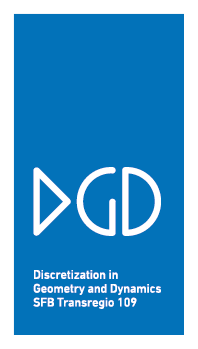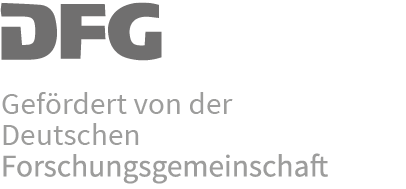First Workshop on Discretization in Geometry and Dynamics (SFB/TR109)
The workshop is part of the Collaborative Research Centre SFB/TRR 109 „Discretization in Geometry and Dynamics“. The main goal is to bring together researchers from the fields of geometry and dynamics and from different research institutions involved in the new research center SFB/TRR109 but also to create interest for the topic amongst graduate students. Besides the presentation of topics related to the different projects the possibility to informally meet and discuss research during the workshop will enhance the cooperation within but also outside the defined research projects in the future.
- Date: 16.12. - 22.12.2012
- Type: Workshop
- Location: Obergurgl
Summary
The workshop is part of the Collaborative Research Centre SFB/Transregio 109 „Discretization in Geometry and Dynamics“ of the Technical University of Berlin and the Technical University of Munich in collaboration with the Free University of Berlin, Vienna University of Technology, and the Graz University of Technology. The workshop is held at the University Center Obergurgl (Austria) from December 16 to 22 2012.
The main goal of the workshop is to bring together researchers from the fields of geometry and dynamics and from different research institutions involved in the new research center SFB/TRR109 but also to create interest for the topic amongst graduate students. Besides the presentation of topics related to the different projects the possibility to informally meet and discuss research during the workshop will enhance the cooperation within but also outside the defined research projects in the future.
The primary focus of the research center is discretization with its application in either geometry or dynamics. In both fields the discretization is the basis for a sophisticated and accurate description of smooth geometric objects and dynamical processes. The resulting discretization should constitute a fundamental mathematical theory incorporating the classical analogue in the continuous limit.
The
workshop is also open to graduate students and is an excellent
possibility to learn more about this fascinating topic.
Organizing Committee:
Alexander
Bobenko
(TU Berlin)
Johannes Wallner (TU Graz)
Susanne
Rudolph-Flöter (TU Berlin)
Pia
Janik (TU Berlin)
Scientific Committee:
Alexander
Bobenko
(TU Berlin)
Folkmar
Bornemann (TU München)
Jürgen
Richter-Gebert (TU München)
Yuri
Suris (TU Berlin)
Günter
Ziegler (FU Berlin)
Location
The
University
Center Obergurgl
is located in a typical Austrian ski resort close to the well-known
ski resort Sölden, Tyrol (Austria) at an elevation of about 2000m
70
km South-West of Innsbruck.
Program
Monday December 17 2012: Informal Scientific Discussions
Tuesday December 18 2012
Morning: Informal Scientific Discussions
15:00-16:00 Richter-Gebert, Jürgen/ Kranich, Stefan (B1/C1): ;GPU-based visualization of algebraic Riemann surfaces’
16:20-16:50 Dimitrov, Nikolay (A1): ‚A variational principle for hyper-ideal circle patterns.’
17:00-17:30 Weißmann, Steffen (A5): ‚A variational integrator for the dynamics of interacting rigid bodies and point vortices’
17:40-18:10 Petrera Matteo (B7): ‚Lagrangian structure of integrable systems’
18:20 – 18:50 Sechelmann, Stefan (A1): ,Uniformization of discrete Riemann surfaces’
ab 20:30 SFB Mitgliederversammlung
Wednesday December 19 2012
Morning: Informal Scientific Discussions
15:00-16:00 Friesecke: “Self-organization of particles into crystalline order and Wulff shapes: a discrete variational picture.”
16:20-16:50 Wechslberger, Georg (B3): ‚Numerics of Riemann-Hilbert problems’
17:00-17:30 Gonchenko, Marina (B4): ‚Exponentially small splitting of separatrices associated to invariant tori with 2 or 3 frequencies’
17:40-18:10 Benedetti, Bruno (A7): ‚Smooth and discrete Morse theory’
18:20 – 18:50 Wawrzinek, Anna (A4): ;Thin Shells and Minimal Surfaces on Catmull-Clark Limit Surfaces'
20:30-21:30 Ziegler: „12 Images that tell Stories“
Thursday December 20 2012
9:00-9:30 Rörig, Thilo (A8): ‚Discretization of asymptotic line parametrizations using hyperboloid’
surface patches"
9:40-10:10 Keller, Johannes (B6): ‚PES-Regularity and Observable Quantum Dynamics’
10:30-11:00 Osberger, Horst (B9): ‚Convergence of a fully discrete variational scheme for a nonlinear Fokker-Planck equation’
11:10-11:40 Lim, Wang-Q. (A10): ‚Multiscale Directional Representations and their Applications’
11:50-12:50 Pottmann, Helmut : ,Recent progress on discrete geometric structures for architecture’
Afternoon: Informal Scientific Discussions
Friday December 21 2012: Informal Scientific Discussions
Abstracts
Dimitrov, Nikolay (A1): ‚A variational principle for hyper-ideal circle patterns.’
The focus of this talk will be on Euclidean hyper-ideal circle patterns on closed surfaces. More precisely, I will outline the key ideas behind the development of a variational principle for the construction of such patterns with prescribed combinatorial and angle properties.
Weißmann, Steffen (A5):
‚A variational integrator for the dynamics of interacting rigid bodies and point vortices’
In this talk we consider the interaction of rigid bodies and point vortices in an inviscid, incompressible 2-dimensional fluid. We formulate the dynamics as a partly degernerate Lagrangian system, derive a momentum-preserving time integrator, and apply the numerical scheme to a number of chaotic and integrable cases
Petrera Matteo (B7): ‚Lagrangian structure of integrable systems’
The main features of the Lagrangian formulation of continuous and discrete systems will be presented. Integrable discrete systems will be embedded in the Lagrangian framework. Aims and outline of B07 will be discussed.
Wechslberger, Georg (B3): ‚Numerics of Riemann-Hilbert problems’
In many cases the standard contour of a Riemann-Hilbert problem is not the most useful one for numerical analysis. For example to calculate the numerical solution of a Riemann-Hilbert problem it is often necessary to deform the contour in a way that reduces its condition. Currently these deformations are done manually and are in many cases similar to deformations used for the asymptotic analysis of Riemann-Hilbert Problems. This talk will describe how some of these deformations can also be done automatically by an algorithm.
Gonchenko, Marina (B4):
‚Exponentially small splitting of separatrices associated to invariant tori with 2 or 3 frequencies’
We study the splitting of invariant manifolds of whiskered (hyperbolic) tori with two or three frequencies in nearly-integrable Hamiltonian systems. In the two-dimensional case, we consider tori whose frequency ratios are quadratic irrational numbers. We deal with numbers whose continued fractions satisfy certain arithmetic properties which give us 24 cases for consideration. In the three-dimensional case, we consider tori with 3 cubic frequencies paying special attention to the cubic golden number. We show that the Poincaré-Melnikov method can be applied to establish the existence of homoclinic orbits to the whiskered tori and prove that these homoclinic orbits are transverse. Thereby, we generalize the results obtained by A. Delshams and P. Guti_errez [1,2] for the golden mean and few other quadratic numbers.
[1] A. Delshams, P. Guti_errez. Zap. Naucn. Sem. S.-Peterburg. Otdel. Mat. Inst. Steklov. (POMI) 300, 87-121 (2003).
[2] A. Delshams, P. Guti_errez. Discrete Contin. Dynam. Systems. 11(4), 757-783 (2004).
Benedetti, Bruno (A7): ‚Smooth and discrete Morse theory’
Morse theory analyzes a smooth manifold by looking at an arbitrary smooth functions defined on it. Its discretization by Forman works on regular CW complexes. We compare the two theories on the common battleground of "triangulations of smooth manifolds", with a special focus on the so-called "Morse inequalities". It turns out that a discrete Morse function often induces a smooth one. As for the converse, a smooth Morse function always induces a discrete one. This is joint work with Karim Adiprasito.
Wawrzinek, Anna(A4):
,Thin Shells and Minimal Surfaces on Catmull-Clark Limit Surfaces'
We present a finite element method based on the use of limit surfaces of Catmull–Clark’s subdivision scheme for describing the geometry and generating smooth interpolated solution fields. The discretization of a geometric differential equation can directly be applied to control grids of Catmull–Clark subdivision surfaces, and, therefore, integrates modeling of Catmull–Clark subdivision surfaces with analysis and optimization of the considered problems. We use the method to analyze the properties of Koiter‘s thin shells and the motion of surfaces by their mean curvature. In the second case minimal Catmull–Clark surfaces were induced. To test the thin shell discretization, we apply it to standard examples for physical simulation of thin shells and compute free vibration modes of thin shells. Furthermore, we use the discrete shell model to set up a deformation-based modeling system for Catmull–Clark subdivision surfaces.
Günter M. Ziegler: ‘The girl who wasn’t good at Math’
I will present a journey into the world of Mathematics, prompted by 24 images.
Johannes Keller (B6): PES-Regularity and Observable Quantum Dynamics’
We discuss the regularity properties of potential energy surfaces with respect to the nuclear coordinates. Potential energy surfaces are eigenvalues of electronic Schrödinger operators that arise as effective potentials for the description of the nuclear motion in the Born-Oppenheimer approximation of molecular quantum dynamics. Furthermore, we introduce different semiclassical approximations for the propagation of quantum expectations and present numerical experiments that validate the results.
Osberger, Horst (B9):
‚Convergence of a fully discrete variational scheme for a nonlinear Fokker-Planck equation’
A full discretization of a scalar drift-diffusion equation is proposed, which is based on the equations variational structure, and convergence in the limit of vanishing step sizes is proven.
Lim, Wang-Q. (A10):
‚Multiscale Directional Representations and their Applications’
Shearlets were introduced as means to sparsely encode anisotropic singularities of multivariate data while providing a unified treatment of the continuous and digital realm. In this talk, recent results on shearlets will be presented, in particular, showing that they provide optimally sparse approximations of piecewise smooth 2D as well as 3D functions. Finally, we will discuss several applications of shearlets.
Pottmann, Helmut:
,Recent progress on discrete geometric structures for architecture’
Discrete differential geometry is a powerful tool for the solution of problems related to the realization of architectural freeform structures. This will be illustrated at hand of recent ongoing research on i) discrete line congruences and their application to support structures and shading systems; ii) hyperbolic nets and rationalization of freeform surfaces and iii) structures in equilibrium and form-finding.
Presentations
coming soon
Participants
Adiprasito, Karim
Apel, Susanne
Benedetti, Bruno
Bobenko, Alexander
Boll, Raphael
Born, Stefan
Bücking, Ulrike
Carl, Wolfgang
Cubelaschwili, David
Dingfelder, Benedict
Dimitrov, Nikolay
Firsching, Moritz
Friesecke Gero
Gonchenko, Marina
Grunert, Romain
Günther Felix
Heydt, Andre
Höbinger, Mathias
Hoffmann, Tim
Huhnen-Venedey, Emanuel
Keller, Johannes
Knöppel, Felix
König, Benno
Kranich, Stefan
Lange, Christian
Lim, Wang-Q.
Matthes, Daniel
Müller, Christian
Osberger, Horst
Padrol, Arnau
Petrera, Matteo
Pinkall, Ulrich
Polthier, Konrad
Pottmann, Helmut
Richer-Gebert, Jürgen
Rörig, Thilo
Rote, Günter
Rudolph-Flöter, Susanne
Sanyal, Raman
Sechelmann, Stefan
Shi, Yang
Springborn, Boris
Skuppin, Lara
Sullivan, John
Suris, Yuri
Thiesen, Isabella
von Deylen, Stefan
von Gagern, Martin
Wallner, Johannes
Wawrzinek, Anna
Wechslberger, Georg
Weißmann, Steffen
Au Yeung, Yuen
Ziegler, Günther
Travel Information
Travel Information to Obergurgl University Center (Universitätszentrum Obergurgl-UZO)
The Obergurgl University Center can be reached by car or by combinations of plane, train and bus.
If you intend to come by plane, try to get a flight to Innsbruck (Austria). If this is not possible you can fly to Munich (Germany), Salzburg (Austria) or Zürich (Switzerland) and take a train from there.
From Innsbruck airport you can arrange a shuttle bus:
Ötztal Shuttle Bus
Or take public transportations:
First by train to Ötztal Bahnhof
(Ötztal station) with OEBB
And then by bus to Obergurgl: Ötztaler Bus
If you prefer to take a taxi, please contact Taxi Tipotsch .
For a detailed description on the venue and travel information see the webpage of the Obergurgl University Center.
Important note:
As the participants of the workshop do not arrive and depart on the same
days, the participants need to arrange the trip to Obergurgl
themselves. Thereby, it is advised to get in contact with other participants to
possibly arrange a taxi or shuttle bus from either the airport or the train
station Ötztal to the University Conference Center.


